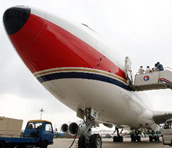PPG cements place
By YANG CHENG (China Daily)
Updated: 2006-09-25 16:32
The company's high-tech low-VOC coatings are used at Shanghai Pudong
Airport.
Volatile organic compounds (VOCs) are gases emitted from certain
decorating materials.
VOCs include a variety of chemicals, some of which
may have short and long-term adverse effects on human health. Concentrations of
many VOCs are consistently higher indoors (up to 10 times higher) than
outdoors.
Low-VOC coatings helped the firm win its huge project from one
of the most important airports in China.
Another breakthrough made by PPG
recently is its high performance, low-emissions glass called Solarban 60.
The glass can reduce heat gain by about 49 per cent in argon-filled
insulating units.
PPG invests more than US$100 million in research and
development (R&D) every year.
"All our goals rely on expertise," said
Combs. "Most of our R&D achievements in use in China are from our labs in
the United States and Europe."
He promised the R&D capacity will be
enhanced in China to meet rising demand.
At present, PPG's architectural
coating sales value in China already accounts for 20 per cent of its global
architectural sales, although it came to China very late compared with its
rivals.
The total sales value of all its businesses, of which coating is
an important part, was US$350 million in China last year, accounting for nearly
4 per cent of its global sales value.
Combs said the nation's drive to
build an energy-efficient and environmentally-friendly society means huge market
potential.
"We will strive to lift our sales in China to 7 to 8 per cent
of our global total in the near future," he said. "Currently, the coating market
in China doesn't have a single dominant player, so PPG will consolidate its
presence gradually in the nation."
|
 Ripe time for Shanghai Port
Ripe time for Shanghai Port